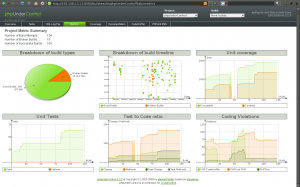 Did you know that you can automate unit tests (which is the PHP worlds equalient of compilation checks 🙂 ).
Did you know that you can automate unit tests (which is the PHP worlds equalient of compilation checks 🙂 ).
Set up your development team using local checkouts of the project and have them do local PHPUnit tests, check their changes in and then get Continuous Integration checks done on a central server using phpUnderControl that emails the team with success/fail reports, it’s a good way to work.
phpUnderControl is an addon application for the continuous integration tool CruiseControl, which integrates some of the best PHP development tools. This project aims to make your first steps with CruiseControl and PHP as easy as possible. Therefore phpUnderControl comes with a command line tool that performs all modifications to an existing CruiseControl installation.
Integrated tools
- Testing and software metrics – PHPUnit is the most popular xUnit implementation for PHP that provides a framework for automated software tests. Except the pure test automation PHPUnit contains a rich set of features like Code Coverage, Project Mess Detection and Software Metrics. To visualize the generated XML reports phpUnderControl comes with a set of XSL stylesheets that prepare the output for CruiseControl.
- Documentation – phpUnderControl uses the most common documentation tool for PHP projects, PhpDocumentor, to generate an up to date documentation of the software on every build cycle. Therefore the developers will always get the latest API documentation of their project. Additionally phpUnderControl extracts the documentation violations found by the PhpDocumentor and visualizes these as an additional quality report in the user interface and the project time line of documentation violations.
- Coding Standards – With the package PHP_CodeSniffer the PEAR project gave PHP developers a very useful tool to detect coding standard violations in a project. Since version 1.0.0RC3 it has native support for the Checkstyle XML format that can be visualized by CruiseControl. PHP_CodeSniffer comes with a variety of pre defined coding standards like PEAR and ZEND but due to its modular structure you can easily implement a custom rule set or extend one of the pre defined sets. This development tool assures that the whole project code will remain clean and consistent.
Go and check it out today 🙂

